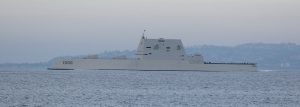[ad_1]
Asia Defense | Security
Announcement is a reversal from earlier plans to deploy weapons on aging missile submarines first.

USS Zumwalt, San Diego coast, November 17, 2018.
Credit: Flickr/Tom Benson
In a shift from earlier plans, the U.S. Navy revealed that it will first deploy advanced hypersonic weapons on advanced surface ships in 2025.
Hypersonic weapons travel in excess of five times the speed of sound, allowing targets to be struck from great distances with little notice, and at speeds that make them exceptionally difficult to defend against. The U.S. military views these weapons as key to countering China’s huge arsenal of long-range missiles that can threaten U.S. bases in Japan or Guam, or potentially target its aircraft carriers at sea.
Speaking to a defense think tank this week, Admiral Michael Gilday, the chief of naval operations, said that the Navy would be deploying hypersonic weapons first on its Zumwalt-class destroyers by 2025, and later on Virginia-class submarines.
The U.S. Navy had been planning on deploying its version of a common hypersonic weapon being developed jointly by the U.S. Army, Navy, and Air Force on its Virginia-class attack submarines around 2028. In a bid to get a hypersonic capability to sea even earlier, an interim capability was under development to put the weapons on the Navy’s aging Ohio-class guided missile submarines by 2025.
These submarines were converted from the U.S. Navy’s four oldest ballistic missile submarines to launch scores of Tomahawk cruise missiles instead of nuclear missiles. These cruise missile submarines are now nearly 40 years old and are scheduled to begin being decommissioned at the end of the decade, around the time that the newer Virginia attack submarines are expected to be ready to carry the new hypersonic weapons.
It is not clear from Gilday’s statements whether the plan to put hypersonic weapons on the Ohio-class guided missile submarines now has been put on hold or will go forward in tandem with the Zumwalt deployment.
There are three Zumwalt destroyers. Plans for a class of 30 or more ships were cut short as costs and technical challenges mounted. The ships were originally designed to field an advanced, long-range cannon to strike targets on land for the U.S. marine corps. That system has effectively been canceled as the costs of the specialized ammunition the guns fire spiraled to more than $800,000 per round. This left the giant destroyers without a main weapon system, and fewer missile launching tubes than the much smaller Arleigh Burke-class destroyers.
After the advanced gun fiasco, the Navy switched the Zumwalt’s primary mission from attacking land targets to long-range strike, since, although it carries fewer missile launchers, they are larger than those on the Navy’s other destroyers and cruisers and so can accommodate newer, larger missiles, such as the hypersonic weapon. The Zumwalt destroyers have been concentrated in San Diego to develop new advanced warfighting concepts, especially how to operate an expanding of autonomous ships and aircraft.
Some analysts worry that hypersonic weapons could make it more likely for a conflict between the United States and China to escalate out of control, since their speed and range create “use it or lose it” incentives to launch before the other country fires against their own sensitive targets, such as bases, communication, or nuclear weapons infrastructure. U.S. sea-based hypersonic weapons somewhat reduce this risk since they are not concentrated at fixed locations on a host country in East Asia, and thus create a potentially inviting target early in a crisis.
[ad_2]
Source link